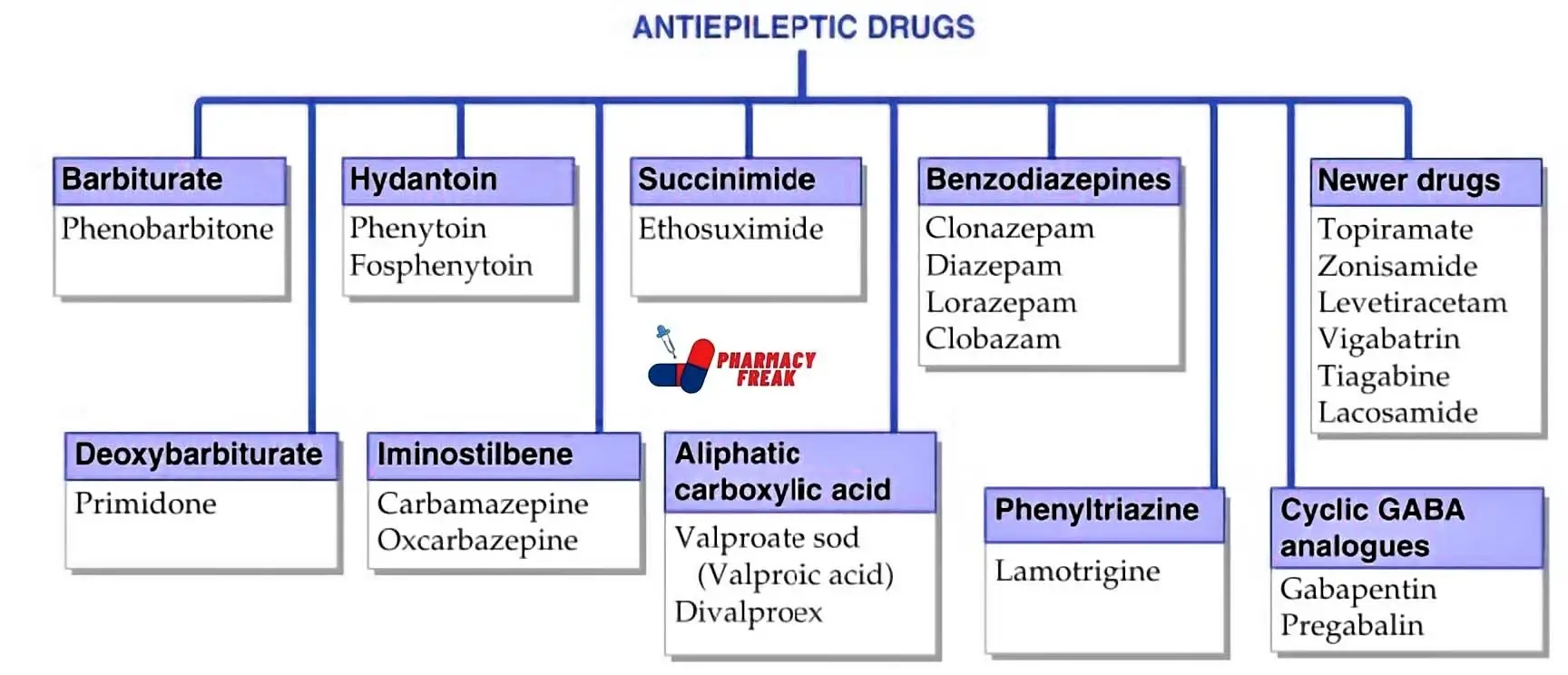Table of Contents
Antiepileptic drugs are categorized into several classes based on their mode of action. Each class targets specific aspects of neuronal activity to prevent seizures. Here are the primary classes of AEDs:
- Barbiturate– Phenobarbitone
- Hydantoin-Phenytoin, Fosphenytoin
- Deoxybarbiturate– Primidone,
- Iminostilbene– Carbamazepine, Oxcarbazepine
- Succinimide- Ethosuximide
- Aliphatic carboxylic acid– Valproate sod (Valproic acid), Divalproex
- Benzodiazepines– Clonazepam, Diazepam, Lorazepam, Clobazam
- Phenyltriazine– Lamotrigine
- Newer drugs- Topiramate, Zonisamide, Levetiracetam, Vigabatrin, Tiagabine, Lacosamide
- Cyclic GABA analogues– Gabapentin, Pregabalin
Sodium Channel Blockers (Voltage-Gated Sodium Channel Inhibitors)
These drugs work by inhibiting voltage-gated sodium channels in neurons, reducing the excitability of these cells. By limiting the influx of sodium ions, these medications help stabilize neuronal membranes, making it less likely for seizures to occur. Common sodium channel blockers include:
- Phenytoin: Effective for partial and tonic-clonic seizures.
- Carbamazepine: Used for various seizure types, including partial, generalized tonic-clonic, and trigeminal neuralgia.
- Lamotrigine: Prescribed for generalized and focal-onset seizures.
Calcium Channel Blockers (Voltage-Gated Calcium Channel Inhibitors)
Calcium channel blockers, primarily used to treat conditions like hypertension and angina, can also have antiepileptic properties. These drugs reduce calcium influx into neurons, which can help control seizure activity. An example of such a drug is Ethosuximide, used for absence seizures.
GABA Enhancers (Gamma-Aminobutyric Acid Enhancers)
Gamma-aminobutyric acid (GABA) is an inhibitory neurotransmitter that helps regulate neuronal excitability. Drugs in this class enhance GABA’s inhibitory effects, reducing the likelihood of seizures. Some common GABA enhancers include:
- Benzodiazepines: Medications like Diazepam (Valium) and Clonazepam (Klonopin) are used for acute seizure control.
- Barbiturates: Though less commonly prescribed today due to their sedative effects, drugs like Phenobarbital can still be used for certain seizure types.
Glutamate Inhibitors
Glutamate is an excitatory neurotransmitter, and excessive glutamate signaling can trigger seizures. AEDs in this class work by inhibiting glutamate receptors, reducing excitatory transmission. Topiramate is an example of a glutamate inhibitor used to treat various seizure types.
GABA Analogs
These drugs mimic the effects of GABA, the brain’s natural inhibitory neurotransmitter. By binding to GABA receptors, they enhance inhibitory signaling, helping to prevent seizures. Gabapentin and Pregabalin are common GABA analogs used in epilepsy management.
Carbonic Anhydrase Inhibitors
Carbonic anhydrase inhibitors like Zonisamide are used to control seizures. They work by reducing neuronal excitability and enhancing inhibitory neurotransmission.
Potassium Channel Modulators
AEDs in this class, like Ezogabine, modulate potassium channels, stabilizing neuronal membranes and reducing the likelihood of seizures.
Miscellaneous AEDs
Some antiepileptic drugs do not fit neatly into the above categories. For instance:
- Valproate: It has multiple mechanisms of action and is used for various seizure types.
- Levetiracetam: Its precise mechanism is not fully understood but involves modulating neurotransmitter release.
Combination Therapies
In cases where a single AED isn’t effective, healthcare providers may prescribe combination therapies, using medications from different classes to achieve better seizure control.
Reference
- Classification of Progestins- KD Tripathi
- National Library of Medicine- Neuropharmacology of Antiseizure Drugs
Related Links

I am a Registered Pharmacist under the Pharmacy Act, 1948, and the founder of PharmacyFreak.com. I hold a Bachelor of Pharmacy degree from Rungta College of Pharmaceutical Science and Research. With a strong academic foundation and practical knowledge, I am committed to providing accurate, easy-to-understand content to support pharmacy students and professionals. My aim is to make complex pharmaceutical concepts accessible and useful for real-world application.
Mail- Sachin@pharmacyfreak.com
